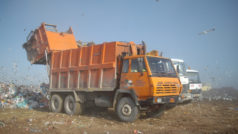Mavrorahi sanitary landfill site – Thessaloniki Prefecture
All non – recyclable waste is delivered to the Mavrorahi sanitary landfill site, which disposes of the waste produced across Thessaloniki Prefecture as well as additional non – recyclable waste from Halkidiki municipalities. The landfill site is operated by FODSA who designed and constructed the landfill to replace the former sanitary landfill site at Tagaredes which closed in 2007 after it had reached its full capacity.
FODSA opened the new Mavrorahi sanitary landfill site in 2008. Civil works were undertaken in advance of the landfill opening at Mavrorahi, including a specially engineered road complete with a bridge for the waste collection and waste transfer vehicles to travel across a ravine to access the landfill site. A special road network in and out of the landfill site, for example, one road for incoming vehicles and one road for outgoing vehicles which had emptied at the landfill, was also constructed. Two weighbridges were built, one to weigh incoming vehicles and one to weigh the outgoing vehicles so their tare weight could be established. The landfill was lined with a liner and the necessary pipework was constructed for the transport of leachate and methane gas out of the landfill site.
Unlike the former Tagaredes landfill open twenty four hours a day enabling the roll – on – off container vehicles to empty containers of waste from Finikas at the tip face of the landfill site twenty four hours a day, the Mavrorahi landfill is open from 07.00am in the morning to 5.00pm on weekdays and 07.00am to 1.00pm on Saturdays and Sundays. To make sure that the waste collection and transfer system was not inconvenienced in Thessaloniki city, FODSA allocated an area outside the landfill for Thessaloniki city to deliver fully loaded roll – on – off containers of waste to the landfill at nights and at weekends in the afternoon. Thessaloniki city would provide several slave roll – on – off vehicles to empty the fully loaded roll – on – off containers inside Mavrorahi in daylight hours once the landfill site was open. Empty containers are also stored outside the landfill so roll – on – off vehicles delivering full containers of waste from Thessaloniki city to Mavrorahi on a twenty four hour cycle can offload full containers and reload with empty containers to take back to Finikas. This makes sure that the waste transfer station always has empty containers and the waste collection and waste transfer system at Finikas is uninterrupted.

Once waste collection and transfer vehicles have been weighed on the first weighbridge at Mavrorahi, they travel along the haul road to the tip face of the landfill to discharge their loads. The waste collection and transfer vehicles head to the second weighbridge at the exit of the landfill to obtain their weighbridge ticket before leaving the site.
The fresh waste deposited at the tip face of the landfill is pushed into the landfill cell by bulldozers for compaction by a Bomag landfill compactor. Bulldozers also spread soil excavated from nearby the landfill over the fresh waste so that it is covered to prevent seagulls and vermin from ferreting in the waste and spreading disease.
The leachate collected from inside the landfill is treated in a desalination plant next to the landfill site. The desalination plant uses Reverse Osmosis technology and polishes the leachate to reduce the levels of Biochemical Oxygen Demand (BOD), Chemical Oxygen Demand (COD) and Ammoniacal Nitrogen in the leachate before being discharged off site through a consented discharge.
Methane is flared off site using a series of flare torches for the different landfill cells. The landfill site complies fully with the requirements of the EU Landfill Directive (1999/31/EC).






